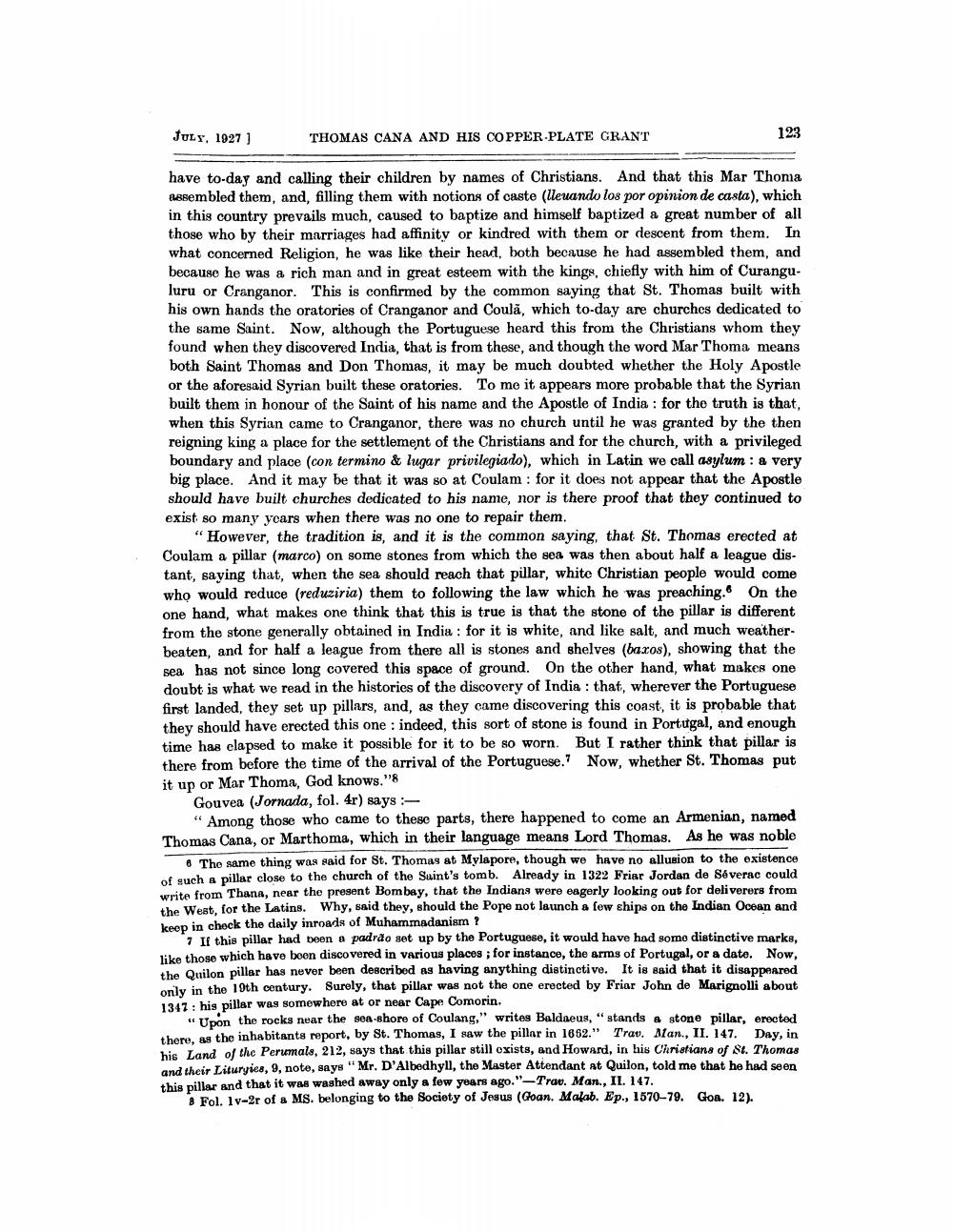________________
JULY, 1927)
THOMAS CANA AND HIS COPPER-PLATE GRANT
123
have to-day and calling their children by names of Christians. And that this Mar Thoma assembled them, and, filling them with notions of caste (lleuando los por opinion de casta), which in this country prevails much, caused to baptize and himself baptized a great number of all those who by their marriages had affinity or kindred with them or descent from them. In what concerned Religion, he was like their head, both because he had assembled them, and because he was a rich man and in great esteem with the kings, chiefly with him of Curanguluru or Cranganor. This is confirmed by the common saying that St. Thomas built with his own hands the oratories of Cranganor and Coulă, which to-day are churches dedicated to the same Saint. Now, although the Portuguese heard this from the Christians whom they found when they discovered India, that is from these, and though the word Mar Thoma means both Saint Thomas and Don Thomas, it may be much doubted whether the Holy Apostle or the aforesaid Syrian built these oratories. To me it appears more probable that the Syrian built them in honour of the Saint of his name and the Apostle of India : for the truth is that, when this Syrian came to Cranganor, there was no church until he was granted by the then reigning king a place for the settlement of the Christians and for the church, with a privileged boundary and place (con termino & lugar privilegiado), which in Latin we call asylum : & very big place. And it may be that it was so at Coulam : for it does not appear that the Apostle should have built churches dedicated to his name, nor is there proof that they continued to exist so many yoars when there was no one to repair them.
"However, the tradition is, and it is the common saying, that St. Thomas erected at Coulam a pillar (marco) on some stones from which the sea was then about half a league distant, saying that, when the sea should reach that pillar, white Christian people would come who would reduce (reduziria) them to following the law which he was preaching. On the one hand, what makes one think that this is true is that the stone of the pillar is different from the stone generally obtained in India : for it is white, and like salt, and much weatherbeaten, and for half a league from there all is stones and shelves (baxos), showing that the sea has not since long covered this space of ground. On the other hand, what makes one doubt is what we read in the histories of the discovery of India : that, wherever the Portuguese first landed, they set up pillars, and, as they came discovering this coast, it is probable that they should have erected this one : indeed, this sort of stone is found in Portugal, and enough time has clapsed to make it possible for it to be so worn. But I rather think that pillar is there from before the time of the arrival of the Portuguese.? Now, whether St. Thomas put it up or Mar Thoma, God knows."8
Gouvea (Jornada, fol. 4r) says -
“Among those who came to these parts, there happened to come an Armenian, named Thomas Cana, or Marthoma, which in their language means Lord Thomas. As he was noble
The same thing was said for St. Thomas at Mylapore, though we have no allusion to the existence of such a pillar close to the church of the Saint's tomb. Already in 1322 Friar Jordan de Séverae could write from Thana, near the present Bombay, that the Indians were eagerly looking out for deliverers from the Weat, for the Latins. Why, said they, should the Pope not launch a lew ships on the Indian Ocean and keep in check the daily inroals of Muhammadanism?
7 If this pillar had been a padrdo set up by the Portuguese, it would have had some distinctive marks, like those which have boon discovered in various places; for instance, the arms of Portugal, or a dato. Now, The Quilon pillar has never been described as having anything distinctive. It is said that it disappeared only in the 19th century. Surely, that pillar was not the one erected by Friar John de Marignolli about 1347: his pillar was somewhere at or near Cape Comorin.
"Upon the rocks near the sea-shore of Coulang," writes Baldaeus, "stands & stone pillar, erected there, as the inhabitants report, by St. Thomas, I saw the pillar in 1882. Trav. Man., II. 147. Day, in hie Land of the Perumals, 212, says that this pillar still exists, and Howard, in his Christians of St. Thomas and their Lituryies, 9, note, says "Mr. D'Albedhyll, the Master Attendant at Quilon, told me that he had seen this pillar and that it was washed away only a few years ago."-Trav. Man., IL 147.
Fol. lv-3r of a MS. belonging to the Society of Jesus (Goan. Malab. Ep., 1570-79. Goa. 12).




